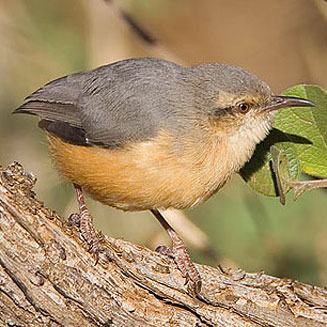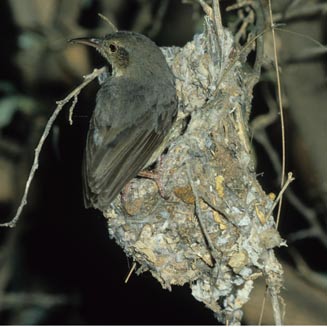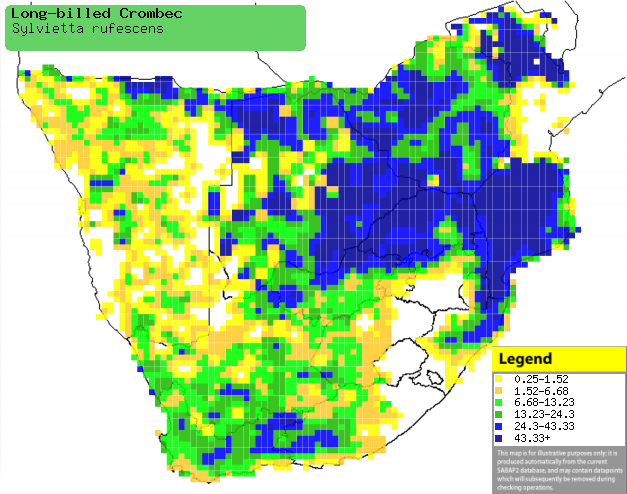|
Sylvietta rufescens
(Long-billed crombec)
Bosveldstompstert [Afrikaans]; iNdibilitshe [Zulu];
Simpanda [Kwangali]; Ngcunywane [Swazi]; Nqcunu [Tsonga]; Kaapse krombek
[Dutch]; Crombec à long bec [French]; Langschnabel-sylvietta,
Kurzschwanz-sylvietta [German]; Rabicurta-de-bico-comprido [Portuguese]
Life
> Eukaryotes >
Opisthokonta
> Metazoa (animals) >
Bilateria >
Deuterostomia > Chordata >
Craniata > Vertebrata (vertebrates) > Gnathostomata (jawed
vertebrates) > Teleostomi (teleost fish) > Osteichthyes (bony fish) > Class:
Sarcopterygii (lobe-finned
fish) > Stegocephalia (terrestrial
vertebrates) > Tetrapoda
(four-legged vertebrates) > Reptiliomorpha > Amniota >
Reptilia (reptiles) >
Romeriida > Diapsida > Archosauromorpha > Archosauria >
Dinosauria
(dinosaurs) > Saurischia > Theropoda (bipedal predatory dinosaurs) >
Coelurosauria > Maniraptora > Aves
(birds) > Order: Passeriformes
> Family: Sylviidae > Genus: Sylvietta
 |
 |
|
Long-billed crombec. [photo
Johann Grobbelaar
©] |
Long-billed crombec on nest. [photo Peter Steyn
©] |
Distribution and habitat
Occurs from eastern DRC, Angola and Zambia south to
southern Africa. Here it is common in arid savanna, the Okavango Delta,
mixed-species woodland with well-developed undergrowth, gardens, Acacia
thickets, Mopane & Miombo woodland.
|
 |
|
Distribution of Long-billed crombec in southern
Africa, based on statistical smoothing of the records from first SA Bird
Atlas Project (©
Animal Demography unit, University of
Cape Town; smoothing by Birgit Erni and Francesca Little). Colours range
from dark blue (most common) through to yellow (least common).
See here for the latest distribution
from the SABAP2. |
Brood parasites
It has been recorded as host of the
Klaas's cuckoo.
Food
It mainly eats invertebrates, supplemented with seeds and
fruit. Often foraging in mixed-species flocks, it gleans food from the leaves
and branches of bushes and trees. The following food items have been recorded
in its diet:
- Invertebrates
- Plants
- seeds
- fruit, including grapes
- nectar
- Aloe greatheadii (Spotted aloe)
- Aloe marlothii (Mountain aloe)
Breeding
- The nest is constructed in about 7-10 days, consisting of a bag-like cup
of stringy plant fibres, leaves, grass and spider web. Often it is decorated
with leaves, rotten wood chips and lumps of spider web and lined with dry
grass. It is typically strung from a droopy tree branch or in the depths of a
bush.
- Egg-laying season is from August-March, peaking from September-January.
- It lays 1-3 eggs, which are incubated by both sexes for roughly 14 days.
- The chicks are fed by both parents, leaving the nest after about 14
days. After at least 10 days they become fully independent.
Threats
Not threatened, in fact common across southern Africa.
References
-
Hockey PAR, Dean WRJ and Ryan PG 2005. Roberts
- Birds of southern Africa, VIIth ed. The Trustees of the John Voelcker
Bird Book Fund, Cape Town.
-
Harrison, J.A., Allan, D.G., Underhill, L.G., Herremans, M.,
Tree. A.J., Parker, V. & Brown, C.J. (eds). 1997. The atlas of southern
African birds. Vol. 2: Passerines. BirdLife South Africa, Johannesburg.
|
